|

Delphi
After
the Acropolis, Delphi
is the most popular archaeological
site in Greece. Located on Mount
Parnassus, north of the Gulf of Corinth and 180 kilometers from
Athens, a trip
to Delphi is listed in just about every tour itinerary and
is by far the most popular day trip out of Athens. Delphi has a special
meaning, more then just another collection of ruins in a
country that is full of them. Delphi in ancient times was
considered the center of the known world, the place where
heaven and earth met. This was the place on earth where man
was closest to the Gods. According to legend, when Zeus
released two eagles from opposite ends of the earth, their
paths crossed in the sky above Delphi establishing the site
as the center of the world.
Delphi is known as the center
of worship for the God Apollo, son of Zeus, who embodied
moral discipline and spiritual clarity. But even before the
area was associated with Apollo there were other deities
worshipped here including the earth goddess Gea (Mother
Earth) and Poseidon (Earth Shaker). The serpent, Python,
son of Gea, was installed in a nearby cave and communication
made through the Pythian priestess. Python was subsequently
slain by Apollo, whose cult had been imported from Crete.
Legend has it that Apollo arrived in the form of a dolphin,
hence the name Delphoi. The Pythian
Games were established to commemorate the event and
perhaps also to placate the ancient deities. By the end of
the 8th century BCE, individuals from all over the ancient
world visited Delphi to consult the god on what course of
action to take, both in public and private life. The
oracle was abolished in 393 CE with the Christianization of
the Byzantine Empire under Theodosius.
Click on the thumbnails below in order to see pictures of Delphi. Use your browser's back button
to return to this page.

|
|
|
|
|
 The
Sanctuary of Apollo is entered through a small agora enclosed by the ruins
of Roman porticoes and shops for the sale of votive offerings. The paved Sacred Way
begins after a few stairs and zigzags uphill between the memorials and
treasuries to the Temple of Apollo. Along each edge is a litter of statue
bases where gold, bronze and painted marble figures once stood. Pliny
counted more than 3,000 and that was after Nero's infamous raid. The
Sanctuary of Apollo is entered through a small agora enclosed by the ruins
of Roman porticoes and shops for the sale of votive offerings. The paved Sacred Way
begins after a few stairs and zigzags uphill between the memorials and
treasuries to the Temple of Apollo. Along each edge is a litter of statue
bases where gold, bronze and painted marble figures once stood. Pliny
counted more than 3,000 and that was after Nero's infamous raid. |
|
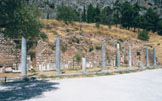 The
restored North Stoa of the Roman Agora. The
restored North Stoa of the Roman Agora. |
|
 The
Monument of the Epigoni, dedicated by the Argives. The
Monument of the Epigoni, dedicated by the Argives. |
|
|
|
|
|
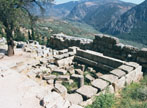 The
Sikyonian Treasury, a Doric structure built in the mid-6th century BCE. The
Sikyonian Treasury, a Doric structure built in the mid-6th century BCE. |
|
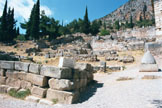 The
Treasury of the Boeotians. The
Treasury of the Boeotians. |
|
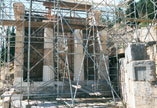 The
Treasury of the Athenians was built in 487 BCE in gratitude to the gods
for the victory at Marathon over the Persians. Like most treasuries, this
small Doric temple contained ex votos dedicated to the gods. The
Treasury of the Athenians was built in 487 BCE in gratitude to the gods
for the victory at Marathon over the Persians. Like most treasuries, this
small Doric temple contained ex votos dedicated to the gods. |
|
|
|
|
|
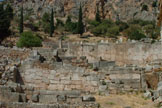 The
Polygonal wall is a retaining wall built after the destruction of the old
temple of Apollo in 548 BCE to support the terrace on which the new temple
was to be erected. The masonry is polygonal and the curved joints of the
stones fit perfectly in place. A large number of inscriptions, mostly
manumissions, are carved on the stones of the wall. The
Polygonal wall is a retaining wall built after the destruction of the old
temple of Apollo in 548 BCE to support the terrace on which the new temple
was to be erected. The masonry is polygonal and the curved joints of the
stones fit perfectly in place. A large number of inscriptions, mostly
manumissions, are carved on the stones of the wall. |
|
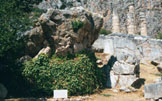 The
Rock of the Sybil with the Temple of Apollo to the right. Apollo was not
the first to provide oracles at Delphi. According to legend, this rock
marks the place where Delphi's first prophetess pronounced her oracles,
perhaps channeling the words of the earth goddess, Gea. The
Rock of the Sybil with the Temple of Apollo to the right. Apollo was not
the first to provide oracles at Delphi. According to legend, this rock
marks the place where Delphi's first prophetess pronounced her oracles,
perhaps channeling the words of the earth goddess, Gea. |
|
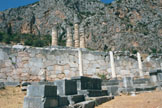 The
Stoa of the Athenians in front of the Polygonal Wall with its large,
irregular blocks and curved joints. The stoa, built in the Ionic order,
has seven fluted columns, four of which are visible in this picture. Each
column is made from a single stone. It was erected by the Athenians in 479
BCE to house the spoils from their naval victory at Salamis over the
Persians. The
Stoa of the Athenians in front of the Polygonal Wall with its large,
irregular blocks and curved joints. The stoa, built in the Ionic order,
has seven fluted columns, four of which are visible in this picture. Each
column is made from a single stone. It was erected by the Athenians in 479
BCE to house the spoils from their naval victory at Salamis over the
Persians. |
|
|
|
|
|
 Ionic
column fragment located along the Sacred Way near the Stoa of the
Athenians. Ionic
column fragment located along the Sacred Way near the Stoa of the
Athenians. |
|
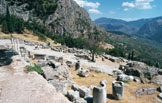 The
Sacred Way as seen from the temple of Apollo. The
Sacred Way as seen from the temple of Apollo. |
|
 The
Altar of the Chians is a stone altar where offerings were made to Apollo.
The large altar is located in front of the temple of Apollo. It was
paid for and erected by the people of the island of Chíos, in the 5th century BCE,
according to an inscription cut on the cornice. The monument was made of
black marble, except for the base and cornice which were of white marble,
resulting in an impressive color contrast. The altar was restored in 1920. The
Altar of the Chians is a stone altar where offerings were made to Apollo.
The large altar is located in front of the temple of Apollo. It was
paid for and erected by the people of the island of Chíos, in the 5th century BCE,
according to an inscription cut on the cornice. The monument was made of
black marble, except for the base and cornice which were of white marble,
resulting in an impressive color contrast. The altar was restored in 1920. |
|
|
|
|
|
 The
stone ramp leading from the Altar of the Chians to the east entrance of the Temple of
Apollo. On the architrave of the temple, probably on the interior,
were inscribed the maxims "Know Thyself" and "Nothing in Excess"
which are as meaningful today as they were when they were
written. The
stone ramp leading from the Altar of the Chians to the east entrance of the Temple of
Apollo. On the architrave of the temple, probably on the interior,
were inscribed the maxims "Know Thyself" and "Nothing in Excess"
which are as meaningful today as they were when they were
written. |
|
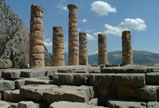 Columns
of the Temple of Apollo, located on the southern tip of the mountain slope. The
Doric temple was the home of the Pythia, who seated on a tripod above a
deep crevasse, would pronounce her prophesies while the priests wrote them
down and translated them to the people. The Pythia was the most famous and respected oracle in
the ancient world. Columns
of the Temple of Apollo, located on the southern tip of the mountain slope. The
Doric temple was the home of the Pythia, who seated on a tripod above a
deep crevasse, would pronounce her prophesies while the priests wrote them
down and translated them to the people. The Pythia was the most famous and respected oracle in
the ancient world. |
|
 The
Temple of Apollo as seen from the west. To the left of the temple is the tall rectangular
stele on which was the statue, probably on horseback, of Prusias, King of
Bithynia (182 - 149 BCE). The
Temple of Apollo as seen from the west. To the left of the temple is the tall rectangular
stele on which was the statue, probably on horseback, of Prusias, King of
Bithynia (182 - 149 BCE). |
|
|
|
|
|
 The
Temple of Apollo with the Phaedriades (Shining Rocks) in the background as seen from the
theater (north). The visible ruins belong to the
last temple, dated to the 4th century BCE, which was peripteral (6 x 15
columns), in Doric
order. It was erected exactly on the remains of an earlier temple, dated
to the 6th century BCE. Inside was the adyton, a dark cell at the
mouth of the oracular chasm where the Pythia, a priestess over the age of
50 who channeled the spirit of Apollo, would officiate. The monument was partly restored
during 1938-1941. The
Temple of Apollo with the Phaedriades (Shining Rocks) in the background as seen from the
theater (north). The visible ruins belong to the
last temple, dated to the 4th century BCE, which was peripteral (6 x 15
columns), in Doric
order. It was erected exactly on the remains of an earlier temple, dated
to the 6th century BCE. Inside was the adyton, a dark cell at the
mouth of the oracular chasm where the Pythia, a priestess over the age of
50 who channeled the spirit of Apollo, would officiate. The monument was partly restored
during 1938-1941. |
|
 The
Theater, located in the northwest corner of the Sanctuary of Apollo,
conforms to the general
design of a Greek Theater. The
cavea had 35 rows of stone benches. The foundations of the skene are
preserved on the paved orchestra. The theatre was closely connected with
Dionysus, the god of ecstasy, the arts and wine, who reigned in Delphi
over the winter months when the oracle was silent. It was used mostly for the
theatrical performances during the great festivals of the sanctuary. The
Theater, located in the northwest corner of the Sanctuary of Apollo,
conforms to the general
design of a Greek Theater. The
cavea had 35 rows of stone benches. The foundations of the skene are
preserved on the paved orchestra. The theatre was closely connected with
Dionysus, the god of ecstasy, the arts and wine, who reigned in Delphi
over the winter months when the oracle was silent. It was used mostly for the
theatrical performances during the great festivals of the sanctuary. |
|
 The Theater
was originally built of limestone from Mount Parnassus in the 3rd century BCE and
many times repaired. The ruins we see today date
from the Roman Imperial period. It is estimated to have held 5,000
spectators. The Theater
was originally built of limestone from Mount Parnassus in the 3rd century BCE and
many times repaired. The ruins we see today date
from the Roman Imperial period. It is estimated to have held 5,000
spectators. |
|
|
|
|
|
 The
main entrance to the Stadium, located to the north of the theater, consists of three arches supported on four
pillars. The two central ones have niches for statues. The
main entrance to the Stadium, located to the north of the theater, consists of three arches supported on four
pillars. The two central ones have niches for statues. |
|
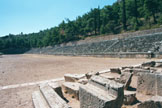 The
track (177.55 m long by 25 m wide) and tiers of seats on the north side of
the stadium viewed from the remains of the entrance archway. Made entirely
of limestone from Mount Parnassus, the present structure's best preserved
seats are located in the lower rows of the 7th cuneus (division) on the
north side. These backed benches were used by the presidents of the games
and honored guests. The
track (177.55 m long by 25 m wide) and tiers of seats on the north side of
the stadium viewed from the remains of the entrance archway. Made entirely
of limestone from Mount Parnassus, the present structure's best preserved
seats are located in the lower rows of the 7th cuneus (division) on the
north side. These backed benches were used by the presidents of the games
and honored guests. |
|
 The
Stadium.
The Pythian Games, one of the four great athletic and drama festivals of
ancient Greece, was held every 4 years in this stadium to commemorate
Apollo's slaying of the serpent Python. The large stadium was famous for its
chariot races and is considered the best preserved in all of Greece. The
Stadium.
The Pythian Games, one of the four great athletic and drama festivals of
ancient Greece, was held every 4 years in this stadium to commemorate
Apollo's slaying of the serpent Python. The large stadium was famous for its
chariot races and is considered the best preserved in all of Greece. |
|
|
|
|
|
 Doorway in the stadium.
The Stadium
was constructed in the 5th century BCE and was remodeled in the 2nd century
CE by the Romans at the expense of Herodes Atticus (101 - 178 CE), the
millionaire Athenian sophist, who added stone seats and the arched monumental entrance.
Greek stadiums (including the one at Olympia)
generally provided merely a sloping, grassy area for those viewing the
events. It held 7,000 spectators. Doorway in the stadium.
The Stadium
was constructed in the 5th century BCE and was remodeled in the 2nd century
CE by the Romans at the expense of Herodes Atticus (101 - 178 CE), the
millionaire Athenian sophist, who added stone seats and the arched monumental entrance.
Greek stadiums (including the one at Olympia)
generally provided merely a sloping, grassy area for those viewing the
events. It held 7,000 spectators. |
|
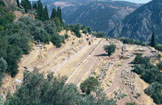 The
Gymnasium was a complex of buildings used by the youths of Delphi for
their education and practice. It was built in the 6th century BCE, perhaps
when the Pythian Games were reorganized, and repaired many times. It was constructed
on many levels due to the sloping terrain. On the
upper level was a stoa and a free open space used for running practice. On
the lower level was the Palaestra (training area), the circular swimming pool and the
roman baths (thermae). The
Gymnasium was a complex of buildings used by the youths of Delphi for
their education and practice. It was built in the 6th century BCE, perhaps
when the Pythian Games were reorganized, and repaired many times. It was constructed
on many levels due to the sloping terrain. On the
upper level was a stoa and a free open space used for running practice. On
the lower level was the Palaestra (training area), the circular swimming pool and the
roman baths (thermae). |
|
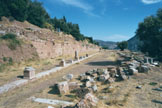 The
Xystos, or covered track of the Gymnasium, on which the athletes practiced running for the Pythian Games. The
Xystos, or covered track of the Gymnasium, on which the athletes practiced running for the Pythian Games. |
|
|
|
|
|
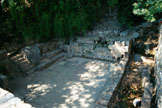 The
underground Castalian Fountain house. It was built at the end of the 7th
century BCE and repaired with slight alterations in the Hellenistic period.
Before entering the Sacred Precinct, it is believed that everyone visiting
Delphi for religious purposes, including the athletes, were required to
bath themselves in the clear but icy waters of the Castalian
Spring. The
underground Castalian Fountain house. It was built at the end of the 7th
century BCE and repaired with slight alterations in the Hellenistic period.
Before entering the Sacred Precinct, it is believed that everyone visiting
Delphi for religious purposes, including the athletes, were required to
bath themselves in the clear but icy waters of the Castalian
Spring. |
|
 Southeast
of the Temple of Apollo is the Marmaria
Precinct, or marble quarry, where
the Sanctuary of Athena Pronoia (Guardian of the Temple) is located. Southeast
of the Temple of Apollo is the Marmaria
Precinct, or marble quarry, where
the Sanctuary of Athena Pronoia (Guardian of the Temple) is located. |
|
 At
the Sanctuary of Athena's entrance stand the ruins of a 4th-century BCE
temple dedicated to Athena (foreground). Beyond it, stands the Marmaria's
most remarkable and most photographed monument: the circular Tholos. At
the far end of the sanctuary (behind the Tholos) lie the remains of an
earlier temple to Athena which was built around 510 BCE. At
the Sanctuary of Athena's entrance stand the ruins of a 4th-century BCE
temple dedicated to Athena (foreground). Beyond it, stands the Marmaria's
most remarkable and most photographed monument: the circular Tholos. At
the far end of the sanctuary (behind the Tholos) lie the remains of an
earlier temple to Athena which was built around 510 BCE. |
|
|
|
|
|
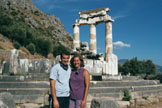 The
Tholos is a circular building in Doric order, built c. 380 BCE. Its function remains unknown but it must have been an important
building, judging from the multi-colored stone, the fine workmanship and
the high-standard relief decoration. The
Tholos is a circular building in Doric order, built c. 380 BCE. Its function remains unknown but it must have been an important
building, judging from the multi-colored stone, the fine workmanship and
the high-standard relief decoration. |
|
 The
three slender restored columns and entablature of the Tholos colonnade, originally
containing 20 columns. The monument was partly reconstructed in 1938. The
three slender restored columns and entablature of the Tholos colonnade, originally
containing 20 columns. The monument was partly reconstructed in 1938. |
|
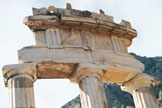 Detail
of the high-standard relief decoration of the Tholos. Detail
of the high-standard relief decoration of the Tholos. |
|
|
|
|
|
© All pictures are Copyright 2000 - 2002 Grisel Gonzalez and Jeff
Prosise
|